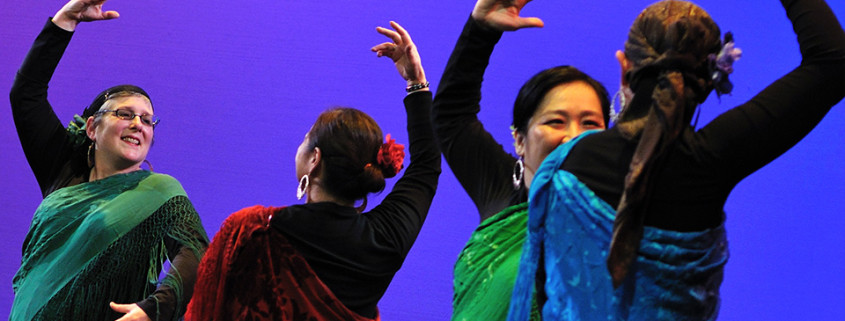Ways students process information and how the instructors present it
By Andrea Williams, Instructor
November 23, 2007
Students often ask me why I teach.
The answer is simple: I teach to learn.
I learn from my students. What makes each person ‘tick’? Why are they here? What do they like about flamenco? As a teacher, I am also continuously learning HOW to teach. It is a process, a process that helps solidify material in your own self, that challenges you to think and be creative, and that forces you to approach the material in different ways.
Not everybody learns in the same way, so you cannot teach the material the same way every time and expect people to ‘get it’. The goal is to make the information easier to absorb by the students, i.e. maximize intake. In class, you may have already noticed this. Some people work better one on one, while others like to be left alone in the back corner to muddle it out for themselves; some want to be shown everything right away, and others like to go through the steps methodically; some need to count, while still others ‘hear’ it in the music and could not tell you what count it was on if their life depended on it (they could, however, tell you it is on the da as opposed to the y).
This term, while learning Sevillanas (prime fodder for this blog!), there have been students in my classes who are:
Visual: “I can do it when you are doing it with us.”
Audio: “I like it better when the music is playing. It is easier.”
Audio-Visual: “Can you show me everything together!”
Kinetic: “Can we do that 100 times more?”
Technical: “Can you break it down?”
Counters: “The chufla is on 1!”
Builders: “First, five sevillana steps, then the linking step (one pasada and one sevillana), then four grapevines…”
Crafters: “Just do it. We can do floreo later.”
A good teacher will accommodate and integrate all of these into her or his lesson, pattern, and habits. There are, after all, great thinkers, scientists, and artists who do not make good teachers because they are unable to explain what is going on in their heads. At Al Mozaico we are lucky, very lucky. Not only do we have the wealth of knowledge and experience that Maestro Oscar brings to the school, but we also have Kasandra La China’s dynamism and thirst for form and creativity, as well as Cyrena’s gift for teaching children. Al Mozaico is really as its name reflects, and this is mirrored in its instructors – we all teach differently and our classes all have a different feel: O ≠ K ≠ A ≠ C!
It certainly helps the learning process if you know how you learn.
Are you a counter?
Do you perform better when you can watch others in front of you or in the mirror?
Do you sing the melody to yourself as you are dancing?
Do you like to do the whole choreography before going back to clean?
Or, do you like to clean as you go?
By identifying how you learn, or what you like in class, you can help yourself learn faster, and more effectively. If you have ever asked yourself these questions, Oscar’s Cognitive Awareness workshops do just that: help you learn how you learn and how to learn better (oscar@mozaicoflamenco.com).
I teach to learn. But, that is admittedly not the whole story. I also teach because I have this insane love and self-described addiction to this art form we call flamenco. And when you love something, you want others to enjoy it as well. This is something my students definitely learn from me.





Leave a Reply
Want to join the discussion?Feel free to contribute!